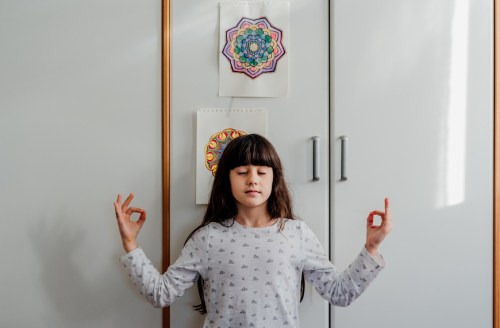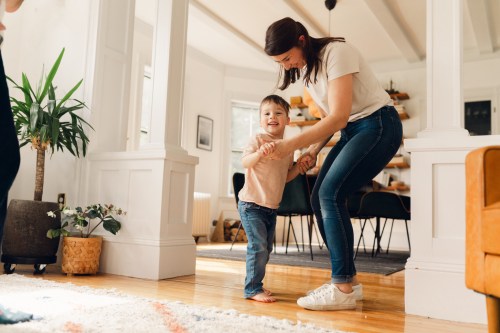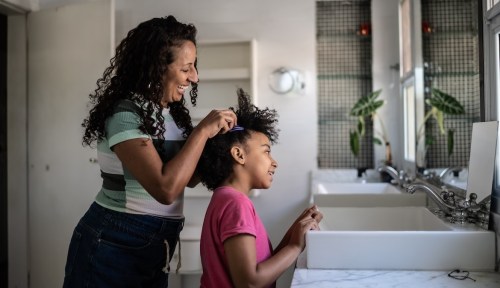If you have kiddos that don’t sleep through the night, it might be time to give meditation a try. New research published in the Journal of Clinical Sleep Medicine found that elementary school children who practiced mindfulness twice a week over the course of two years slept an average of 74 extra minutes per night. This data offers compelling support for the idea that teaching children mindfulness practices from an early age can be beneficial to their well-being; but how, exactly, do you get the smallest members of your family to “sit still,” mentally? What do mindfulness activities for kids even look like?
Experts in This Article
Helen Egger, MD is a pediatric doctor, early childhood mental health expert, digital health expert, and prolific scientist. She is the founder of Little Otter, a children’s mental health practice.
How do you introduce your children to mindfulness activities for kids
Children enter the world “quite present,” says Blake Lown Beers, founder of Little Renegades, a company that makes mindfulness products and educational tools for children. But as they begin to grow, their brains develop in ways that allow rumination, nervousness, and anxiety to creep in. “So the question is, how do we start building in language and practices and everyday approaches around mindfulness early—as young as two or three—so that…they’re pretty equipped to navigate some of those big feelings,” Beers says.
There are many ways to practice mindfulness, but Beers notes that there are five main pathways you can use when thinking about teaching your kids: breathwork, gratitude, affirmation, movement (yoga, stretching, or any movement that makes you hyper-aware of your body), and sensory awareness (which involves calling attention to the five senses). For example, you might practice a breathing exercise with your children, ask them to share what they’re grateful for, or take them outside to observe the nuances of a single tree.
For the best chance at success, engage in these activities with your child, says Helen Egger, MD, child psychiatrist and founder of Little Otter, a children’s mental health practice. “Don’t say, ‘Go practice your breathing’,” she says. “Say, ‘Come practice your breathing with me.'” This way, you’re modeling the behaviors you want to see while making practice feel less like homework.
Beers also suggests repeating exercises in order to form mindfulness habits. “In the same way that we teach our children to brush their teeth before bed, this is a mental hygiene piece that we’re trying to instill in them,” she says. And try not to overthink it, she adds, noting that people often ask her how long they should be practicing with their kids each night. “Just do it for as long as it’s interesting to the kid—the last thing we want is for this to feel laborious,” she says.
In the study, children were taught what stress is and shown ways to relax through breathing exercises. They also received training that helped bring their attention to the present moment and learned yoga-like activities. Not sure where to start with your own little ones? Below, you’ll find 6 specific mindfulness activities for kids that can be easily incorporated into your child’s life to improve their overall well-being (and maybe gain you an extra hour of sleep, too).
6 mindfulness activities for kids that can equip them with tools to cope
1. Stop and tune into the five senses
Part of mindfulness is inhabiting the present moment, and Dr. Egger says there are plenty of opportunities to bring kids’ focus back to the now. You might take them on a nature walk, for example, and lead them through each of their five senses, e.g. “What do you smell? What do you hear?”
You don’t have to be somewhere special to do this, either. Dr. Egger says you can engage in this activity in line at the grocery store, as an example. “It can be a really nice way, just in found moments, to teach your child to open their eyes and ears to what is actually happening around them,” she says, adding that you can turn this into a game.
2. Practice belly breathing
“Belly breathing is one of the easiest and most helpful ways that you can teach your child mindfulness,” says Dr. Egger. To do this, she suggests lying down on the floor with your child and placing your hands on your belly. Then, you breathe in so that your belly gets big (like you’re filling a balloon with air), and then you slowly let the air out of the “balloon.” “This is one of the core skills you teach in mindfulness, and it not only centers a child and soothes their nervous systems, but it also gives them a tool to use if they’re (or, you’re) feeling stressed or frantic,” says Dr. Egger.
3. Try a bedtime body scan meditation
Learning to practice mindfulness at bedtime can be super helpful, as it can enable kids to fall asleep more easily, now and as they grow up. To this end, Dr. Egger recommends a practice she has used with her own children. “They lie down, and you have them close their eyes. Then you start at the toes and say, ‘Make your toes totally relaxed, your toes are so tired,’ and then you work your way up to the ankles and the calves and so on,” she says. “It’s a great way—like belly breathing—to teach your child that we can relax our bodies, and…that helps us deal with stress.” Usually, she says, her kids fell asleep before she reached their belly buttons.
4. Engage in three-breath hugs
Another mindfulness practice that parents can use with their children is the three-breath hug, which is exactly what it sounds like—you and your child both take three deep inhales and exhales together while you embrace. This isn’t just about quieting the mind. It’s about getting in touch with our feelings, bodies, and the world around us, Dr. Egger says. While hugging is a great stress-reliever, this exercise includes an embrace because it’s an easy and organic way for kids to engage in a mindful moment, she explains. Activities for children are, after all, most effective if parents are participating, too.
5. Use mindfulness prompts designed for children
If you need more concrete help creating mindful moments with your child, you might consider finding or using prompts that nudge your children to be a little more attentive. Beers’ company, Little Renegades, created prompt decks that utilize animal characters to ground kids. For example, one card instructs children to “put on their fox ears,” says Beers. This helps them to tune into one sense—their hearing. “It makes them hyper-focused on the environment around them,” she says.
Once the child becomes familiar with ‘putting on their fox ears’ (or any of the other prompts in the deck), you can lean on it anytime you need a mindful moment or reset. “The idea is that over time, you build enough of these tools that they start to have little ways to become aware if they are feeling big things, or if they’re needing a bit of pause or a bit of stillness,” says Beers. “It builds a little bit more of a mindfulness routine into their everyday lives.”
6. Use a mindfulness journal
Journaling is a tried and true mindfulness tool, and there are notebooks that are specifically geared toward children. Little Renegade has three different types (one for outdoor exploration, one for creativity, and one for practicing gratitude) with prompts specifically designed to create mindful moments for children ages seven and up. “The journals are a space for processing, and really helping them tune in,” Beers says.
Some mindful journaling techniques might resonate with your child more than others, but trial and error can be a fun process. And even if your little one doesn’t miraculously begin to sleep an extra hour each night, they’re benefitting in other ways. “The value for children is being able to be aware of their feelings, their thoughts, their bodies, and how they’re experiencing stress in a particular moment,” says Dr. Egger. “It gives them ways to observe those things, and to get the centered experience that comes from just being right here, right now.”
Oh hi! You look like someone who loves free workouts, discounts for cult-fave wellness brands, and exclusive Well+Good content. Sign up for Well+, our online community of wellness insiders, and unlock your rewards instantly.
Sign Up for Our Daily Newsletter
Get all the latest in wellness, trends, food, fitness, beauty, and more delivered right to your inbox.
Got it, you've been added to our email list.










